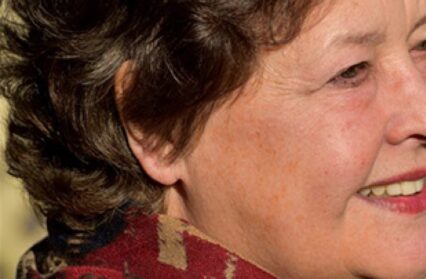Rhian Davies celebrates the work of composer Hilary Tann, who has passed away at the age of 75.
Hilary Tann – my close friend and collaborator who has died unexpectedly aged 75 – was a prolific composer whose imaginative catalogue was shaped by her formative years in Wales, her adoptive home in America, and her cultural affinity with Japan. Renowned for her fastidious craftsmanship and mastery of counterpoint, she produced lyrical music of great integrity to express the synaesthesia that she experienced directly in nature and through the condensed energy of poetry. ‘I write for the pleasure of the performers and listeners,’ she said, ‘and a glance at my titles reveals my joy in simply being alive in this wondrous green world.’ Invited to become a house composer by Oxford University Press in 1989, she worked almost exclusively to commission from international promoters and performers, and her scores have been widely recorded, including several solo discs of orchestral, chamber, choral and vocal music.
Hilary Tann’s Welshness did not stem from traditional sources like folksong, the harp or the language, but rather from the geology of the landscape and the play of light and weather upon it. Her mind returned repeatedly to the rock formation called Craig Cerrig-gleisiad and the high moorland above her native Ferndale in the Rhondda that she had walked as a child with her parents, where cotton grass and wildflowers grew among the granite and the mountain came close to the sky. Here, The Cliffs, The Walls of Morlais Castle and Light from the Cliffs all emerged from this hallowed landscape, and The Cresset Stone and Melangell Variations are rooted in similarly ‘thin places’ at Brecon Cathedral and Pennant Melangell. Welsh writing in English was another essential influence: George Herbert, Dylan Thomas, Menna Elfyn, and R. S. Thomas, in whose questing faith she found an ideal echo, notably in Seven Poems of Stillness for solo cello (her own instrument) and the recorded voice of the poet.
Tann discovered traditional Japanese music through the playing of Ronnie Nyogetsu Seldin, a master of the shakuhachi or vertical bamboo flute with whom she studied in New York for seven years. She made three extended visits to Japan and her compositions responded by assimilating landscaped lines and timbral and temporal contrasts. From Afar and Shakkei (‘borrowed scenery’ in garden design) were especially well received with performances in Europe, Asia, North and South America. Tann also spent time in China, South Korea and Thailand, and inscribed The Open Field: ‘In memoriam Tiananmen Square (June 1989)’ when that tragedy unfolded as she completed her score. A highly-regarded haiku poet and a founding member of the Route 9 Haiku Group at the Dim Sum Restaurant in Halfmoon, she co-chaired the Haiku North American Conference that attracted a hundred delegates to upstate New York in 2015. Tann appreciated how haiku kept her in the moment whereas composition always required her to plan ahead, and would dial her office answerphone to report a poem.
Key works that confirmed Tann as a transatlantic as well as an exiled composer were Adirondack Light, Nothing Forgotten and Some of the Silence. She never felt entirely at ease in America until she realised that the lives of the men in the logging industry paralleled those of the miners in the south Wales coalfield, meaning that she could bring her Welshness to that area and it would feel at home. Tann enjoyed hiking and canoeing to remote locations in the Adirondack Mountains to prepare for her compositions, immersing herself in the Woodswoman novels of the ecologist Anne LaBastille and incorporating snippets into her scores of traditional songs collected by George and Vaughn Ward. Other multi-movement works respond more directly to the stimulus of words or pictures: In the Theater of Air, seven sound-images of birds in flight after the poetry of Mary Oliver, and her string quartet, And the Snow Did Lie, which interprets ten lithographs by André Bergeron. The critic Joseph Dalton praised the idiom of the quartet as ‘shimmering and weightless… atmospheric and immersive’ and indicative of ‘the grounded spiritual ecstasy that is Tann’s distinctive musical outlook’.
Hilary Tann began composing at the age of six and was the first woman to gain a First Class Honours degree in composition from Cardiff and the third to take a Doctorate at Princeton, studying with Alun Hoddinott (1965-8), J. K. Randall and Milton Babbitt (1972-81). She always intended to return to Wales, but America gradually became home as she worked her way up the Hudson through teaching appointments to Bard College, Annandale (1977-80), Williams College, Williamstown (1979), and Union College, Schenectady (1980-2019), where she chaired the Department of Performing Arts, lectured in composition and theory, and retired as John Howard Payne Professor of Music Emerita. A Board Member of the International League of Women Composers (1982-95) and Composer-in-Residence at the Eastman School of Music Women in Music Festival (2011) and Women Composers Festival of Hartford (2013), other significant performances included Carnegie Hall, Pan-American Games, North American Festival of Wales, BBC Hoddinott Hall, and the Last Night of the Welsh Proms at St David’s Hall, Cardiff.
Students and colleagues of Hilary Tann have been expressing their profound sadness at the premature loss of a beloved and generous mentor and a singular personality of radiant charm. She has bequeathed her archive to the National Library of Wales and will be buried in Ferndale:
hillside cemetery
all gravestones
face the view
ht
Hilary Tann, was born in Ferndale, Rhondda Fach, Glamorgan, Wales on 2nd November 1947; she passed away in Schuylerville, New York, U.S.A. on 8th February 2023.
M. the composer John McCabe, her piano teacher at Cardiff; (2) the jazz musician Jeff Presslaff; (3) David Bullard, who shared her deep interest in Japan and survived her by ten days at their historic home, The Marshall House.












